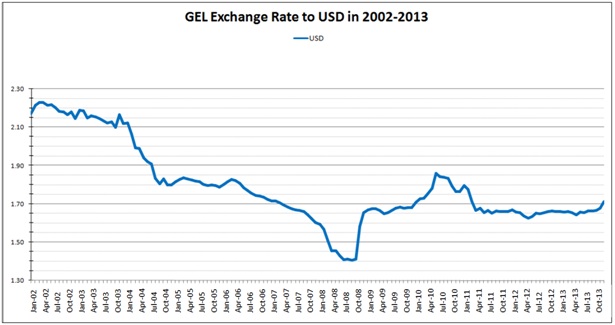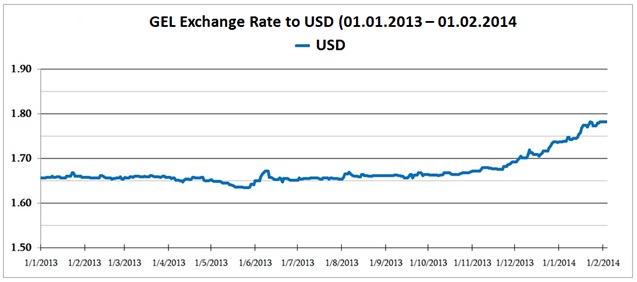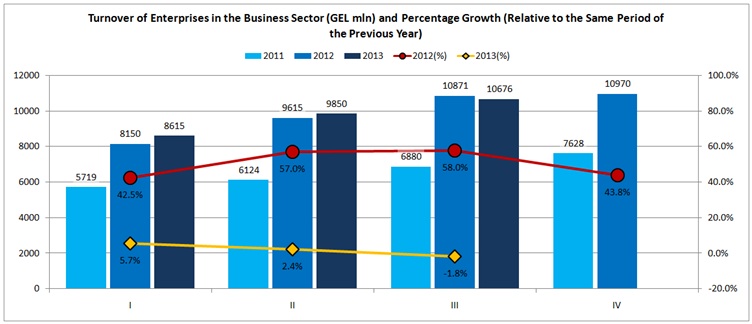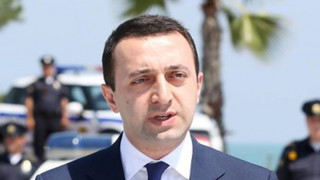Appearing on the TV programme Pozicia aired on 27 December 2013 on Rustavi 2, the Prime Minister of Georgia, Irakli Gharibashvili, stated: “We have witnessed a downturn in the GEL currency rates on multiple occasions in the past as well. In the third quarter of the year [2013] we saw a serious revitalisation and a recovery of the economy. In line with the data of the third quarter, the total trade turnover of the companies in the private sector amounted to GEL 30 billion. A comparison of this figure to the indicator of the first quarter reveals a growth of 24% in the third quarter. Our forecasts for the following year are based upon the prediction of a 5% economic growth. This is a real prognosis which has been confirmed by the International Monetary Fund, the World Bank and other international organisations.”
FactCheck took interest in the PM’s statement and inquired about its accuracy.
Throughout the past ten years, up until 2008, the GEL had been mainly strengthening (with respect to the USD) and starting from 2011 stabilised around the exchange rate of 1.65. However, since November of 2013, GEL exchange rates in respect to the USD have been falling.
As the USD is employed in the international trade more often than any other currency, we decided to analyse the variations in GEL exchange rates solely with respect to the USD.

 GEL exchange rates to the USD saw a significant decline in 2010 and the first half of 2011. In June of 2010 the rate reached 1.8875 while in the second half of 2011, it stabilised around the indicator of 1.65. Therefore, the Prime Minister falsely claims that the fall in GEL exchange rates had been observed on multiple occasions in the previous years as well.
As for the revitalisation of the economy in the third quarter of the past year, this matter has been researched by FactCheck in a previous article.
In accordance with the publication of the International Monetary Fund published in October 2013, the forecasted growth rate of the Georgian real GDP in 2014 was set at 5%; the 2014 state budget of Georgia foresees the same 5% growth rate in the real GDP and 8.7% growth rate in nominal GDP. The projected nominal GDP for 2014 is defined roughly in the amount of GEL 29.35 billion.
In line with the data of the first three quarters of 2013, the turnover of enterprises amounted to GEL 29,141 million. In 2012 the same indicator stood at GEL 28,636 million. Accordingly, the comparison of the first three quarters of 2013 to the three quarters of 2012 reveals an increase of 1.76%.
GEL exchange rates to the USD saw a significant decline in 2010 and the first half of 2011. In June of 2010 the rate reached 1.8875 while in the second half of 2011, it stabilised around the indicator of 1.65. Therefore, the Prime Minister falsely claims that the fall in GEL exchange rates had been observed on multiple occasions in the previous years as well.
As for the revitalisation of the economy in the third quarter of the past year, this matter has been researched by FactCheck in a previous article.
In accordance with the publication of the International Monetary Fund published in October 2013, the forecasted growth rate of the Georgian real GDP in 2014 was set at 5%; the 2014 state budget of Georgia foresees the same 5% growth rate in the real GDP and 8.7% growth rate in nominal GDP. The projected nominal GDP for 2014 is defined roughly in the amount of GEL 29.35 billion.
In line with the data of the first three quarters of 2013, the turnover of enterprises amounted to GEL 29,141 million. In 2012 the same indicator stood at GEL 28,636 million. Accordingly, the comparison of the first three quarters of 2013 to the three quarters of 2012 reveals an increase of 1.76%.
 As for the quarterly growth in particular, in comparison to the same periods of the previous year, the first and second quarters of 2013 saw an increase of 5.7% and 2.4%, respectively. However, in the third quarter, the indicator took a downturn of 1.8%.
It is to be emphasised that the comparison of indicators corresponding to the first and third quarters is economically unjustified as Georgia employs no mechanism of seasonal adjustment. Therefore, for the assessment of growth of the business sector turnover, the indicators of the third quarter of 2013 need to be compared to those of the same period of 2012. The described circumstance has been repeatedly pointed out by the Minister of Finance, Nodar Khaduri, as well.
In general, business activity is significantly bigger in the third and fourth quarters relative to the first. The indicators of the third quarter of 2013, for instance, exceed those of the first by 23.9%. The same is confirmed by the statistical data of 2011 and 2012. In those years the indices of the third quarter were notably larger than the indicators of the first quarter: in 2012 – by 33.4%, while in 2011 – by 20.3%.
Conclusion
In the course of our research it has been established that the GEL had been strengthening with respect to the USD up until 2008. Currency rates dropped in 2010-2011, however stabilised again later around 1.65. Accordingly, currency rates have not seen a downturn “on multiple occasions” as claimed by the Prime Minister. It is likely that currently, as well, we are facing a similar process and the currency rate will return to its initial indicator after having experienced a short-term devaluation. This opinion has also been supported by numerous experts and officials.
As for the forecast of economic growth in 2014, the report of the International Monetary Fund published in October 2013 forecasts the growth rate of the Georgian GDP at 5%; the same figure is foreseen in the 2014 state budget of Georgia. Moreover, in the report of the World Bank published in January 2014 the growth of the Georgian GDP was forecast to equal 6.3%. Therefore, in this part, the statement of Irakli Gharibashvili is accurate.
Discussing the private sector, the Prime Minister makes an economically unjustified comparison between the first and third quarters of 2013. Although the figure indicated by him corresponds to the real percentage of growth between those two quarters, the comparison of the first and third quarters does not produce any viable results. Comparing the third quarter of 2013 to the same indicator of the preceding year, we observe a decline of 1.8% in the turnover of enterprises. Consequently, in the third quarter of 2013, the trade turnover took a downturn and the Prime Minister’s assertions in this regard are false.
We conclude that Irakli Gharibashvili’s statement: “We have witnessed a downturn in the GEL currency rates on multiple occasions in the past as well. In the third quarter of the year [2013] we saw a serious revitalisation and a recovery of the economy. In line with the data of the third quarter, the total trade turnover of the companies in the private sector amounted to GEL 30 billion. A comparison of this figure to the indicator of the first quarter reveals a growth of 24% in the third quarter. Our forecasts for the following year are based upon the prediction of a 5% economic growth. This is a real prognosis which has been confirmed by the International Monetary Fund, the World Bank and other international organisations,” is MOSTLY FALSE.
As for the quarterly growth in particular, in comparison to the same periods of the previous year, the first and second quarters of 2013 saw an increase of 5.7% and 2.4%, respectively. However, in the third quarter, the indicator took a downturn of 1.8%.
It is to be emphasised that the comparison of indicators corresponding to the first and third quarters is economically unjustified as Georgia employs no mechanism of seasonal adjustment. Therefore, for the assessment of growth of the business sector turnover, the indicators of the third quarter of 2013 need to be compared to those of the same period of 2012. The described circumstance has been repeatedly pointed out by the Minister of Finance, Nodar Khaduri, as well.
In general, business activity is significantly bigger in the third and fourth quarters relative to the first. The indicators of the third quarter of 2013, for instance, exceed those of the first by 23.9%. The same is confirmed by the statistical data of 2011 and 2012. In those years the indices of the third quarter were notably larger than the indicators of the first quarter: in 2012 – by 33.4%, while in 2011 – by 20.3%.
Conclusion
In the course of our research it has been established that the GEL had been strengthening with respect to the USD up until 2008. Currency rates dropped in 2010-2011, however stabilised again later around 1.65. Accordingly, currency rates have not seen a downturn “on multiple occasions” as claimed by the Prime Minister. It is likely that currently, as well, we are facing a similar process and the currency rate will return to its initial indicator after having experienced a short-term devaluation. This opinion has also been supported by numerous experts and officials.
As for the forecast of economic growth in 2014, the report of the International Monetary Fund published in October 2013 forecasts the growth rate of the Georgian GDP at 5%; the same figure is foreseen in the 2014 state budget of Georgia. Moreover, in the report of the World Bank published in January 2014 the growth of the Georgian GDP was forecast to equal 6.3%. Therefore, in this part, the statement of Irakli Gharibashvili is accurate.
Discussing the private sector, the Prime Minister makes an economically unjustified comparison between the first and third quarters of 2013. Although the figure indicated by him corresponds to the real percentage of growth between those two quarters, the comparison of the first and third quarters does not produce any viable results. Comparing the third quarter of 2013 to the same indicator of the preceding year, we observe a decline of 1.8% in the turnover of enterprises. Consequently, in the third quarter of 2013, the trade turnover took a downturn and the Prime Minister’s assertions in this regard are false.
We conclude that Irakli Gharibashvili’s statement: “We have witnessed a downturn in the GEL currency rates on multiple occasions in the past as well. In the third quarter of the year [2013] we saw a serious revitalisation and a recovery of the economy. In line with the data of the third quarter, the total trade turnover of the companies in the private sector amounted to GEL 30 billion. A comparison of this figure to the indicator of the first quarter reveals a growth of 24% in the third quarter. Our forecasts for the following year are based upon the prediction of a 5% economic growth. This is a real prognosis which has been confirmed by the International Monetary Fund, the World Bank and other international organisations,” is MOSTLY FALSE.

 GEL exchange rates to the USD saw a significant decline in 2010 and the first half of 2011. In June of 2010 the rate reached 1.8875 while in the second half of 2011, it stabilised around the indicator of 1.65. Therefore, the Prime Minister falsely claims that the fall in GEL exchange rates had been observed on multiple occasions in the previous years as well.
As for the revitalisation of the economy in the third quarter of the past year, this matter has been researched by FactCheck in a previous article.
In accordance with the publication of the International Monetary Fund published in October 2013, the forecasted growth rate of the Georgian real GDP in 2014 was set at 5%; the 2014 state budget of Georgia foresees the same 5% growth rate in the real GDP and 8.7% growth rate in nominal GDP. The projected nominal GDP for 2014 is defined roughly in the amount of GEL 29.35 billion.
In line with the data of the first three quarters of 2013, the turnover of enterprises amounted to GEL 29,141 million. In 2012 the same indicator stood at GEL 28,636 million. Accordingly, the comparison of the first three quarters of 2013 to the three quarters of 2012 reveals an increase of 1.76%.
GEL exchange rates to the USD saw a significant decline in 2010 and the first half of 2011. In June of 2010 the rate reached 1.8875 while in the second half of 2011, it stabilised around the indicator of 1.65. Therefore, the Prime Minister falsely claims that the fall in GEL exchange rates had been observed on multiple occasions in the previous years as well.
As for the revitalisation of the economy in the third quarter of the past year, this matter has been researched by FactCheck in a previous article.
In accordance with the publication of the International Monetary Fund published in October 2013, the forecasted growth rate of the Georgian real GDP in 2014 was set at 5%; the 2014 state budget of Georgia foresees the same 5% growth rate in the real GDP and 8.7% growth rate in nominal GDP. The projected nominal GDP for 2014 is defined roughly in the amount of GEL 29.35 billion.
In line with the data of the first three quarters of 2013, the turnover of enterprises amounted to GEL 29,141 million. In 2012 the same indicator stood at GEL 28,636 million. Accordingly, the comparison of the first three quarters of 2013 to the three quarters of 2012 reveals an increase of 1.76%.
 As for the quarterly growth in particular, in comparison to the same periods of the previous year, the first and second quarters of 2013 saw an increase of 5.7% and 2.4%, respectively. However, in the third quarter, the indicator took a downturn of 1.8%.
It is to be emphasised that the comparison of indicators corresponding to the first and third quarters is economically unjustified as Georgia employs no mechanism of seasonal adjustment. Therefore, for the assessment of growth of the business sector turnover, the indicators of the third quarter of 2013 need to be compared to those of the same period of 2012. The described circumstance has been repeatedly pointed out by the Minister of Finance, Nodar Khaduri, as well.
In general, business activity is significantly bigger in the third and fourth quarters relative to the first. The indicators of the third quarter of 2013, for instance, exceed those of the first by 23.9%. The same is confirmed by the statistical data of 2011 and 2012. In those years the indices of the third quarter were notably larger than the indicators of the first quarter: in 2012 – by 33.4%, while in 2011 – by 20.3%.
Conclusion
In the course of our research it has been established that the GEL had been strengthening with respect to the USD up until 2008. Currency rates dropped in 2010-2011, however stabilised again later around 1.65. Accordingly, currency rates have not seen a downturn “on multiple occasions” as claimed by the Prime Minister. It is likely that currently, as well, we are facing a similar process and the currency rate will return to its initial indicator after having experienced a short-term devaluation. This opinion has also been supported by numerous experts and officials.
As for the forecast of economic growth in 2014, the report of the International Monetary Fund published in October 2013 forecasts the growth rate of the Georgian GDP at 5%; the same figure is foreseen in the 2014 state budget of Georgia. Moreover, in the report of the World Bank published in January 2014 the growth of the Georgian GDP was forecast to equal 6.3%. Therefore, in this part, the statement of Irakli Gharibashvili is accurate.
Discussing the private sector, the Prime Minister makes an economically unjustified comparison between the first and third quarters of 2013. Although the figure indicated by him corresponds to the real percentage of growth between those two quarters, the comparison of the first and third quarters does not produce any viable results. Comparing the third quarter of 2013 to the same indicator of the preceding year, we observe a decline of 1.8% in the turnover of enterprises. Consequently, in the third quarter of 2013, the trade turnover took a downturn and the Prime Minister’s assertions in this regard are false.
We conclude that Irakli Gharibashvili’s statement: “We have witnessed a downturn in the GEL currency rates on multiple occasions in the past as well. In the third quarter of the year [2013] we saw a serious revitalisation and a recovery of the economy. In line with the data of the third quarter, the total trade turnover of the companies in the private sector amounted to GEL 30 billion. A comparison of this figure to the indicator of the first quarter reveals a growth of 24% in the third quarter. Our forecasts for the following year are based upon the prediction of a 5% economic growth. This is a real prognosis which has been confirmed by the International Monetary Fund, the World Bank and other international organisations,” is MOSTLY FALSE.
As for the quarterly growth in particular, in comparison to the same periods of the previous year, the first and second quarters of 2013 saw an increase of 5.7% and 2.4%, respectively. However, in the third quarter, the indicator took a downturn of 1.8%.
It is to be emphasised that the comparison of indicators corresponding to the first and third quarters is economically unjustified as Georgia employs no mechanism of seasonal adjustment. Therefore, for the assessment of growth of the business sector turnover, the indicators of the third quarter of 2013 need to be compared to those of the same period of 2012. The described circumstance has been repeatedly pointed out by the Minister of Finance, Nodar Khaduri, as well.
In general, business activity is significantly bigger in the third and fourth quarters relative to the first. The indicators of the third quarter of 2013, for instance, exceed those of the first by 23.9%. The same is confirmed by the statistical data of 2011 and 2012. In those years the indices of the third quarter were notably larger than the indicators of the first quarter: in 2012 – by 33.4%, while in 2011 – by 20.3%.
Conclusion
In the course of our research it has been established that the GEL had been strengthening with respect to the USD up until 2008. Currency rates dropped in 2010-2011, however stabilised again later around 1.65. Accordingly, currency rates have not seen a downturn “on multiple occasions” as claimed by the Prime Minister. It is likely that currently, as well, we are facing a similar process and the currency rate will return to its initial indicator after having experienced a short-term devaluation. This opinion has also been supported by numerous experts and officials.
As for the forecast of economic growth in 2014, the report of the International Monetary Fund published in October 2013 forecasts the growth rate of the Georgian GDP at 5%; the same figure is foreseen in the 2014 state budget of Georgia. Moreover, in the report of the World Bank published in January 2014 the growth of the Georgian GDP was forecast to equal 6.3%. Therefore, in this part, the statement of Irakli Gharibashvili is accurate.
Discussing the private sector, the Prime Minister makes an economically unjustified comparison between the first and third quarters of 2013. Although the figure indicated by him corresponds to the real percentage of growth between those two quarters, the comparison of the first and third quarters does not produce any viable results. Comparing the third quarter of 2013 to the same indicator of the preceding year, we observe a decline of 1.8% in the turnover of enterprises. Consequently, in the third quarter of 2013, the trade turnover took a downturn and the Prime Minister’s assertions in this regard are false.
We conclude that Irakli Gharibashvili’s statement: “We have witnessed a downturn in the GEL currency rates on multiple occasions in the past as well. In the third quarter of the year [2013] we saw a serious revitalisation and a recovery of the economy. In line with the data of the third quarter, the total trade turnover of the companies in the private sector amounted to GEL 30 billion. A comparison of this figure to the indicator of the first quarter reveals a growth of 24% in the third quarter. Our forecasts for the following year are based upon the prediction of a 5% economic growth. This is a real prognosis which has been confirmed by the International Monetary Fund, the World Bank and other international organisations,” is MOSTLY FALSE.








